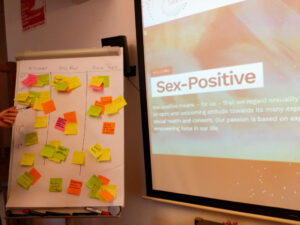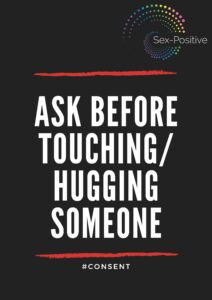tags: consent, conflict, procedure
© CC BY-SA 3.0 DE by Working group CVCR compiled by Estelle (for CEBI/Creation dEspaces
Bienveillants et Inclusifs) , Katya, Sky, Amelie, Boris, Marc Seestaedt, edited into flowing text by SunnivaKey elements to consent violation response and conflict resolution is non-violent communication, unaffected third parties when possible, and a focus on the personal experience of the reporter and those involved who were harmed or hurt.
Conflict Resolution Flowchart Draft: https://sketchboard.me/FBAS7DyuYwqT
Image file: https://drive.google.com/open?id=1xMg0OBXE8kSIoEGoFQBlkBOGZYrN-KBpWe can divide consent violation response and conflict resolution into three steps that we will befollowing in this guide:
1. Recording
2. Process
3. Consequences
1.Recording
At this stage, our main responsibility is to create a safer space for listening and support. We act as receivers and mirrors of the reporters’ experience. We do not ask any intrusive questions, and we do not place judgement. We receive information and make sure that we are not interpreting the reporter in any way. Ideally, we are not sexually or emotionally involved with the reporter from before. Affected parties are recomended to withdraw themselves from the process of recording.
We encourage non-violent and empathic communication while dealing with these issues. Tell the person they can share anything they want, but that they are not obliged to share anything. You can ask “Did I understand you correctly?”, while avoiding intrusive questions.
Remember, it doesn’t matter whether the reported incident feels minor to you. In some countries, receiving information of a legal crime will oblige you to report this to the police. In other countries, this is the decision of the person(s) involved. Please make sure you have an overview of these legal obligations in the country where you or your community are or where your event takes place. It is also possible for the reporter to choose to remain anonymous. In this case, you are not obliged to make a report to law enforcement. We are neither therapists nor lawyers. It is reccomended to handle recording in a careful manner. If you receive a report of a serious violation, we reccomend you use physical recording methods (eg. pen and paper) without a digital footprint, for legal safety reasons.
At this stage, you would need to make a decision whether you have to protect the community/organization/space holders as well as the reporter. Our goal is to get an understanding of what the reporter(s) need.
- Do they feel safe with us sharing this information with others?
- Are they comfortable with us contacting the person(s) involved in the incident?
- Are they comfortable with us reporting their incident to the organizer or law enforcement?
The reporter might also need immediate support. Be mindful of your own presence. Stay calm and collected. Breathe openly, helping them re-center themselves, and if this interaction happpened at an event, offer them something to eat or drink, and recommend not to lay down if they seem overwhelmed, as this might trigger a deeper emotional shutdown.
Offer them to contact a friend for immediate support from someone they trust and know. It can be helpful to have a list of resources available, including helplines, sexologists, therapists and lawyers.
Many communities and event organizers use online reporting systems and forms. Here is an example from the burner community Firefly in Canada: https://airtable.com/shrrDNEUC657KRPCK . When there is already a structure for receiving reports, be mindful of who has access to these documents.
2.Process
Use the Code of Conduct or agreed upon rules as a basis for deciding the next steps
- Form teams to investigate the report
- Prioritize the safety and well-being of the reporter first, then community/transparency, and third the violator
- What are you doing for the person on the recording
- And what are you doing for the
organization and the community?- Do they need mediation?
- Who is responsible?
- How many people were involved in the incident?
- Is the reported person anewbie or a veteran in this environment?
- Your job is to clarify the risk;
- Does the person reported pose a risk to the reporter?
- Do they pose a risk to the rest of the group or community?
- Is this a legal matter?
- Be aware that sometimes issues occur because of badly organized spaces, and other times
because of badly behaved individuals. Intent is not the same then the Impact it has- Does the incident demand an internal procedure or an external procedure ?
It is important to have people not in power involved in this process, and for this it can be good to form teams to investigate report.
- Interaction
- Make sure to protect and be there for the reporter
Speak to the reported person, with consent from the reporter.- Is the reported person in denial?
- Is it the first time they are involved in a report?
- If three people are reporting, you might have to question organizational responsibility; if you
have five people reporting, you definitely have an organizational problem to resolve- It is important to listen to everyone involved with the same openness and kindness
- It is important for those involved to know that something is happening, and it is important to communicate this to the community
- There is often a need for the community to know and evolve and learn
- Sometimes there is a responsibility to not share, and keep silence
- Tell the person reporting it’s not their fault and it was not their decision
- Be clear on the values and your role
- Refer to a clear code of conduct or rules
- Does the reported person pose a risk to the community?
- Is the reported person open to change?
- Talk in person to others present at the event.
- Ask:
- What is your perception of that person?
- How do you feel about that person?
- How did that person behave towards you?
- What does the reporter need and what does your community or group need?
Be mindful of how you open and close spaces for these conversations.
3.Consequences
- We try to grow up together, and learn from our mistakes
- Creating focused consent games and workshops in response to incident Yellow cards, and holding people responsible
- Offer a space for reflection within group or community
- You can offer a workshop, or a sense of transformative process
- Safety pods: at least one experienced person to hold space. Working on consent and safety issues. Make sure to close a space that you opened!
- Make a manifest: this happened, and it’s not ok, and these are the conseqences. Use engaging and supportive formulations like “We prefer …”, “we understand that beginners …”
© CC BY-SA 3.0 DE by Working group CVCR compiled by Estelle (for CEBI/Creation dEspaces
Bienveillants et Inclusifs) , Katya, Sky, Amelie, Boris, Marc Seestaedt, edited into flowing text by Sunniva



